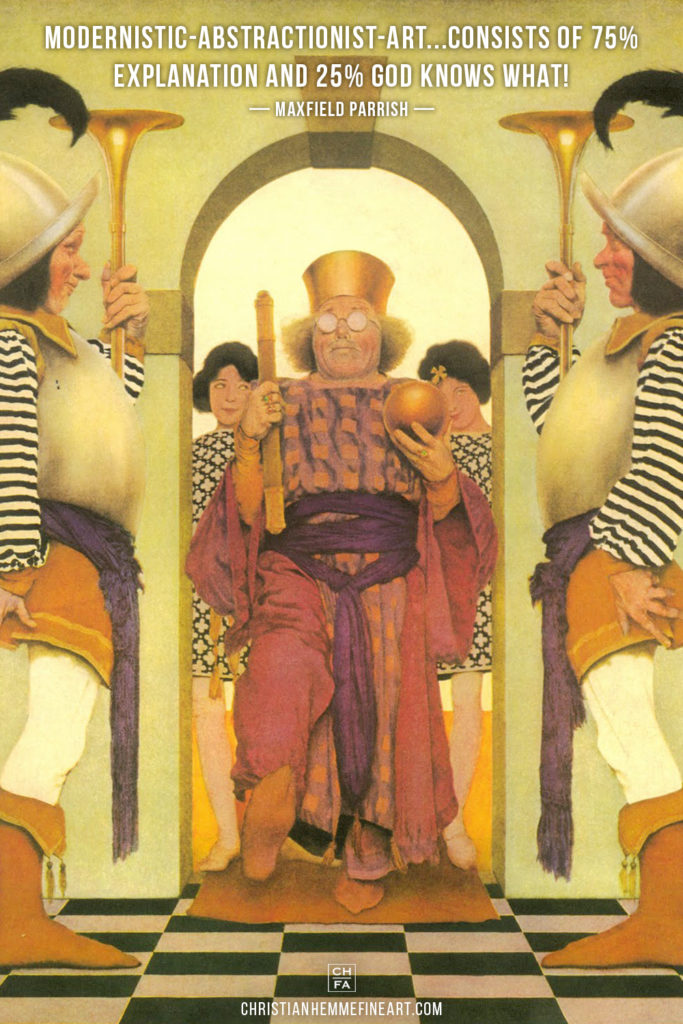The Great Fine Art Fix | Artist Quotes | Maxfield Parrish
“Modernistic-Abstractionist-Art… consists of 75% explanation and 25% God knows what!”
—Maxfield Parrish
Learn more about Maxfield Parrish, who lived from 1870 to 1966.
The Great Fine Art Fix
110.5 million dollars. What an absolutely mouth-watering sum! An extremely wealthy individual spent that amount on just one item recently. What did that staggering figure buy, you ask?
“Okay, that’s a pretty penny, how about a brand-new Gulfstream G650ER luxury personal jet?”
Don’t be silly: $110.5 million could buy nearly two of those.
“Some piece of extraordinary jewelry, perhaps? An extravagant diamond set in platinum?”
Not even close. The most expensive single piece of jewelry in modern history sold for a reported $80 million.
Apparently the United States Government can even build a thermonuclear bomb, including launch platform, for less than $100 million.
You’re killin’ us Smalls, what’s the answer for goodness’ sake?
How about a piece of graffiti depicting a stylized skull on a blue background?
…‘Cause that’s the right answer.
Is it worth it?
How Did We Get Here?
I found this example of the absurdity of the modern “fine art” market after watching a video on social media. This entertaining clip, which I’ve shared below, revealed some seriously shady dealings regarding the high-end buying and selling of artwork.
The importance of a worldview cannot be underestimated. Because a worldview always leads to action: both by individuals and by societies.
[bctt tweet=”…a worldview always leads to action: both by individuals and by societies. —Christian Hemme” username=”chemmefineart”]
Dress for Success
In our Western cultural mindset (which has clearly taken hold all around the industrialized world), we place great importance on success. This can take several forms including affluence and wealth, prestige and importance, power and influence, or knowledge and learning. We revere these traits and laud those who possess them.
And for probably the first time in history, this sort of success is labeled as available to everyone. “Follow your dreams,” or “you can do anything you put your mind to” represent common proverbs of today.
This Weltanschauung of success has, I believe, taken top spot above nearly every other ideal. On the stage of world politics, dictators and presidents grasp for it. In television or movies, actors and actresses portray it…then try to live it out in real life. Athletes pour their every waking moment into their sport, hoping to clutch it. Academicians vie for prizes and publications to showcase their mastery of it.
Or occasionally, we see something like a graffiti skull. What better way to declare to the world “I’ve arrived,” than to purchase inferior, kitsch, shocking art for an obscene amount of money?
But I think the single most common area we can see this striving for success is…
In the mirror.
Where, in MY daily life, am I grasping for my own accolades, my own power, my own prominence in the eyes of the world?
To quote the renowned writer, poet, and philosopher G.K. Chesterton, when answering a Times inquiry asking “What’s wrong with the world today…”
I am.
Some Things are Worth It
Once again, please don’t hear what I’m not saying! After all, I’m a working artist: I certainly encourage people to spend good money on good quality artwork. In fact, quality makes up part of my business slogan: Beauty. Quality. Culture.
These three attributes stem from my personal convictions. Some things merit a thousand dollar purchase. Or ten thousand. Or one million. And yes, even 100 million.
But the foundational Weltanschauung reveals the true validity of the purchase.
Economists talk a lot about opportunity cost, “a benefit that a person could have received, but gave up, to take another course of action.” In our example, what else could have been done with that $100 million? We hear about the children in Africa all the time. And it might be cliche, but those kids still need food. Or if this collector wanted to invest specifically in art (a great idea, but I’m biased), how about funding classical art education in the schools?
But obviously this sort of opportunity cost extends beyond art purchases. And so does a worldview that grasps for success—or at least the appearance of success. What about electronics? Or furniture? How about cars? Or houses? I think in every circumstance, the underlying, crucial question remains…
Is it worth it?
Question: What do you believe is “worth it” when it comes to spending money? Let us all know in the comment section below!






I am not bothered by the “hustle” ti takes to sell a painting for the maximum profit, unless illegal… but please… DON’T call this modern crap ART!
Thanks for that comment Art! I’d imagine most people would agree with your statement regarding illegality: thank goodness our laws recognize on many levels the importance of protecting artists! My only concern would be about the wide gray area regarding “hustle.” I would bet that these galleries and auction houses who artificially create perceived value and “buzz” around this type of modern work would say that’s exactly what they’re doing: nothing illegal, just selling paintings for maximum profit. The deciding factor in my reasoning comes under the realm of morality, not legality.